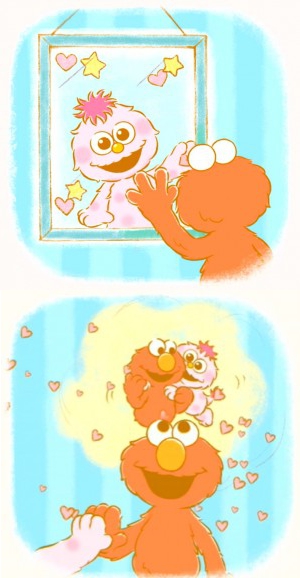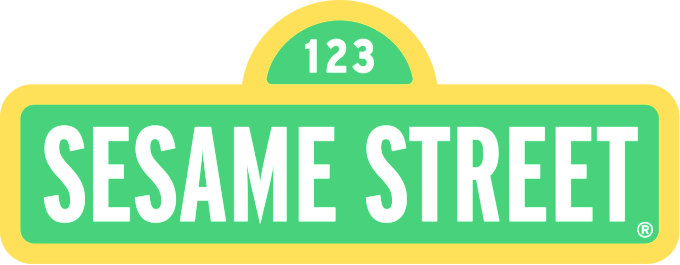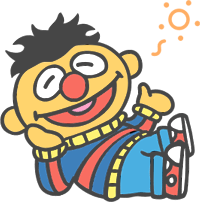A Brief History
.jpg)
In 1967, Joan Ganz Cooney, an American television producer, took note of the overwhelming amount of children that were able to memorize and recite advertisement jingles from their abundant repetition on television. When discussing this observation in a dinner party with psychologist Lloyd Morrisett, a crucial question was posed: "Can television be used to educate children?" Seeing this as a great research opportunity, Cooney took action and gathered with a team of psychologists and early childhood educators to begin conducting research.
Under the name of the non-profit production company, Children's Television Workshop, it was suggested that to keep the constant attention of young children, fast-paced, flashy, and comedic visuals would be needed. .gif) Well known for his slapstick-style and humorous commercials of the 1950s, puppeteer Jim Henson (primarily puppeteered Kermit and Ernie) was approached about working for CTW and contributing to the show with his innovative puppets, which differed greatly from that of the typically used marionette. After some hesitation (puppetry already had a reputation for being an artform solely for children), Henson obliged and by 1969, he began creating content for the show, which would later be dubbed Sesame Street. On November 10, 1969, the first episode of Sesame Street would air. It proved to be a massive success for CTW and a great feat in children's education through television.
Well known for his slapstick-style and humorous commercials of the 1950s, puppeteer Jim Henson (primarily puppeteered Kermit and Ernie) was approached about working for CTW and contributing to the show with his innovative puppets, which differed greatly from that of the typically used marionette. After some hesitation (puppetry already had a reputation for being an artform solely for children), Henson obliged and by 1969, he began creating content for the show, which would later be dubbed Sesame Street. On November 10, 1969, the first episode of Sesame Street would air. It proved to be a massive success for CTW and a great feat in children's education through television.
Thanks to the extensive amount of research, effort, and testing put in by the show's dedicated staff, Sesame Street is widely known for its immense impact on children's educational television. For 50 years (as of 2019), Sesame Street has been educating children worldwide on their ABC's, 123's, kind relations, health, cultural acceptance, and much more. I'm so happy to have grown up with this show and its eccentric cast of characters. ❤ Here's to hoping it will continue to educate generations of children for years to come! ❤

.gif)
.gif)
.gif)

Why I Love Sesame Street
.jpg) Despite Sesame Street's target audience being 3-5-year-olds, there are tons that still love to reminisce in the nostalgia that comes with re-experiencing one of their favorite childhood shows and the memories all they associate with it.
Despite Sesame Street's target audience being 3-5-year-olds, there are tons that still love to reminisce in the nostalgia that comes with re-experiencing one of their favorite childhood shows and the memories all they associate with it.
Aside from the nostalgia aspect, I love the humor used in Sesame Street episodes from the 70s-90s! The characters would interact in a way that preschoolers could comprehend, while still being humorous enough for both children and adults to laugh with. This is why I especially love Bert & Ernie sketches (Fun fact: Jim Henson and Frank Oz never really kept the fact that they were puppeteering for children in mind while performing Bert & Ernie. They were just having fun, doing their own thing c: ) from this early era. ❤
Because of the target demographic for Sesame Street continuously getting younger, I always feel hesitant to share my interest in it. I feel like many people initially think it's unusual to have an immense interest in the Muppets, let alone Sesame Street. Despite this, I've come to realize that this is just another.png) interest that I treat like any other. I love learning about its long history, puppeteers, and character interactions. There's 50 years worth of content, songs, and stories to explore, which just makes it all the more interesting to me. Regardless of Sesame Street being for children so young, there's nothing wrong with having an interest in it. I take it as being interested in any other kind of media made for children, as the level of interest is the same. Being aware that hundreds of others share the same interest makes it a bit easier for me to express my appreciation for Sesame Street. ❤ Even more so, having places like the Muppet forums and news sites to discuss Sesame Street makes me realize that it's completely fine to be interested and share my interest with others. It's ok to have a genuine appreciation and interest in something for a younger audience, no matter how old you are! ❤
interest that I treat like any other. I love learning about its long history, puppeteers, and character interactions. There's 50 years worth of content, songs, and stories to explore, which just makes it all the more interesting to me. Regardless of Sesame Street being for children so young, there's nothing wrong with having an interest in it. I take it as being interested in any other kind of media made for children, as the level of interest is the same. Being aware that hundreds of others share the same interest makes it a bit easier for me to express my appreciation for Sesame Street. ❤ Even more so, having places like the Muppet forums and news sites to discuss Sesame Street makes me realize that it's completely fine to be interested and share my interest with others. It's ok to have a genuine appreciation and interest in something for a younger audience, no matter how old you are! ❤
Some of my favorite songs:
- Imagination - Ernie Joe Raposo, 1972
- Same and Different - Prairie Dawn & Tyne Daly Tony Geiss, 1990
- Little Things - Prairie Dawn Joe Raposo, 1972
- My Favorite Number Is 6 - Bert Jeff Moss, 1977
- Lots of Stuff - Bert & Ernie Joe Raposo, 1972
- South America Way - Louise Gold Fernando Rivas, 1992
- Frau Holle - Bert, Finchen, and Ernie 2013
- What's the Name of That Song - Bert & Ernie Sam Pottle, 1974
- Batty Bat - Count Von Count Joe Raposo, 1985
- Imagine That - Ernie Jeff Moss, 1985
- This Frog - Kermit Sam Pottle, 1976
- I Don't Want To Live On The Moon - Ernie Jeff Moss, 1978
.jpg)
.jpg)
Favorite Characters:
- About
- HOME
- links
- extras
.png)
1. Ernie
.png)
2. Prairie Dawn
.png)
3. Bert
.png)
4. Kermit
.png)
5. Count Von Count
.png)
6. Rosita
.png)
7. Don Music
.png)
8. Grizzy
.png)
9. Betty Lou
.png)
10. Twiddle Bugs
.jpg)
.jpg)
.png)
.jpg)
.jpg)
.jpg)
Fun Facts
- Bert and Ernie are the only Muppets that have been on Sesame Street since the pilot episode.
- Big Bird, Oscar, Bert, Ernie, and Cookie Monster are the only Muppets that have remained on Sesame Street since the first episode.
- Originally, while finding voices for Bert and Ernie for the first time, Bert's voice was done by Jim Henson while Ernie's was done by Frank Oz. After switching roles, they decided to keep the ladder roles, making for the notable voices of Ernie and Bert that we know today, done by Jim Henson and Frank Oz respectively.
- Ernie genuinely enjoys brussel sprouts.
- Oscar the Grouch had initially been designed as being magenta. However, throughout the first season, Oscar was orange. He soon changed to the kelly green color that we know him to be for season 2. He claims that "Most of the family was orange. But I had a lovely vacation in Swamp Mushy Muddy resort. It was so dark and dreary I kind of turned green. I accidentally took a bath once, turned orange again and washed all the moss off, so I went right back to Swamp Mushy Muddy, and here I am". Essentially, Oscar still remains orange underneath all of the moss that coats him.
- The show was banned in Mississippi for its multiracial cast of human characters in 1970. However, the state soon revoked its decision.
- Up until Elmo's popularity boost in the '90s, Big Bird was considered the OG Elmo. He was the face of Sesame Street's Sesame Place in Pennsylvania and the star of many Sesame Street Live! shows. One individual claims that, prior to Elmo's surge in popularity, "It was hard to walk around the city without seeing a Big Big toy in a baby's stroller".
- The primary reason for Sesame Street's abundance of celebrity appearances, pop culture references, and song parodies is to keep parents engaged with their children. Researchers found that children are more receptive to educational television when watching with a parent, so the interests of parents were kept in mind during the production of Sesame Street. Not only is it enjoyable and humorous for children, but for adults as well!
- As of 2018, Sesame Street has won 189 Emmy Awards.
- Sesame Street has its own theme park, Sesame Place, located in Middletown Township, Pennsylvania. It is the first theme park to be a Certified Autism Center, as it caters greatly to the needs of those with autism by providing information regarding sensory input levels throughout the park, well-trained staff, and secure quiet rooms.
- Moppy is a Sesame Street walk-around character created exclusively for the Sesame Street section of Universal Studios Japan. He serves as a cute, happy visual representation of luck, surprises, and making dreams come true, making him fairly popular with Japanese audiences that share a liking towards kawaii culture.
- Passionate, yet bitter fans (rightfully so) of Sesame Street's prime (before Elmo was the main character) often refer to Elmo as "little red menace" out of spite for him "taking over the show".
- Apple's streaming service is preparing to release a new Sesame Street spin-off, Helpsters, to teach kids the basics of coding logic. The show is planned to release sometime in the fall of 2019, exclusively for Apple TV+ members.
- Despite Sesame Street having a reputation of being a child-friendly kid's TV show, "Sesame Street: Old School" was released as a set of DVD's featuring episodes from 1969-1984. This set included a few Sesame Street episodes and segments qith content that would be considered questionable to some by today's standards. These early segments depicted characters like Lefty, a vague representation of a drug salesman, brief depictions of a young girl's undergarments being shown in one of the first openings, children riding bikes without helmets, and a young girl taking the hand of and walking around Sesame Street with a man who is a complete stranger to her.
- On May 1, 2019, the intersection in New York of West 63rd Street and Broadway was renamed "Sesame Street" in honor of Sesame Street's 50th anniversary.
.png)
.jpg)

.png)
.jpg)
.png)
Links
Sesame Street YT - Official Sesame Street US YouTube channel
SesmaeStreet.org - Official Sesame Street US website with games and activites
Sesame Street Wiki - Sesame Street Wiki that contains information on everything from international merch to live shows
Tough Pigs - Sesame Street & Muppet news
Muppet Mindset - Sesame Street & Muppet news
.gif)

.gif)
